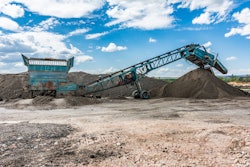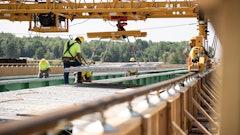
There are a lot of changes in store for the asphalt industry, and not just for producers. These changes will affect any contractor who deals in asphalt. Since the passage of the Infrastructure Investment and Jobs Act (IIJA) and then the Inflation Reduction Act (IRA), a lot of discussions have focused on the large amounts of funding related to projects related to infrastructure. However, there's another facet to these laws, as well as more funding opportunities, that may be even more important in the long run of things.
Environmental product declarations, commonly referred to as EPDs, are going to fundamentally alter the paradigm of the asphalt business. That potentially generates a lot of anxiety, and questions. Thankfully, to help you through it, NAPA Director of Sustainable Pavements Joseph Shacat is leading an educational session at CONEXPO-CON/AGG on Wednesday, March 15, 2:30pm in the West Hall 226.
What is an EPD and Why Should I Care?
For those not able to attend CONEXPO this year, or unable to make it for Shacat's 45-minute session, you surely still have lots of questions surrounding EPDs. Let's start with the basics.
What is an EPD? To put it in the most understandable and relatable terms, it's a lot like the nutritional label on the back of the box, bag, or can you buy at the grocery store. In our case, rather than dietary information about ingredients, calories, and vitamins, the EPD provides asphalt customers with the basic environmental impact information related to the production of a specific asphalt mixture at your plant.
"An EPD is a document, it's a report," said Shacat. "The scope of that is cradle to gate. Everything from extracting raw materials to transporting your materials to your asphalt plant, to plant operations right up until it leaves your gate. This is so important because it provides the basis to measure or assess a product's potential sustainability benefits or drawbacks."
The EPD acts as a label for your product, quantifying the emissions and other environmental impacts associated with making it. This means wherever that asphalt goes, it will carry that documentation with it, which is important in newly emerging procurement policies. At every level of government, from the federal all the way down to local policy stakeholders, customers are beginning to require contractors to provide these EPDs for the mixes that they deliver on a project.
"More and more customers are going to ask for it," Shacat said. "In some markets, already, like in Colorado, for example, if you want to do any work for either see CDOT or any state agency, you're going to be required to produce an EPD. If you're doing any federal contract work with the General Services Administration (GSA), for their projects, you're required to produce an EPD."
But the shift to EPD requirement isn't isolated to the public sector, because private corporations are shifting as well. ”A large corporation that answers to the American public is going to require EPDs too, because they want to get LEED credits or other benefits,” added Shacat. “Even if you don't own an asphalt plant, you should at least know something about EPDs, so you know what they're asking for and you know what to ask of your mix supplier."
Driving a Substantive Level of Change
Under the Federal Buy Clean policy, which for the first time prioritizes the use of American-made, lower-carbon construction materials in Federal procurement and Federally-funded projects, asphalt is listed as one of the four materials as a major priority for federal procurement. Additionally, the Federal Highway Administration (FHWA) has, as part of its "Every Day Counts" initiative, EPDs for Sustainable Project Delivery. This puts the asphalt industry, and all the new technological advances squarely in the crosshairs of state DOTs.
"It's a pretty big deal to have any technology in 'Every Day Counts', because that means you have the attention of all the regional offices across the country," said Shacat. "It's a deployment effort, in the sense that it's going to provide as many resources as possible for agencies to adopt these new technologies. FHWA provides all the information about a product to persuade agencies to move forward."
Of course, the real driver is the money that is on the table now. Through the IRA and distributed through the EPA, hundreds of millions of dollars will be used to exclusively help the industry develop EPDs, upgrade their technology and production processes, and offset the higher price tags that might be associated with switching to raw and reused materials with a lower embodied carbon footprint. With the industry operating as a system based on low-bid wins, the ability to offset the higher costs of doing low-emissions business means everything. All this to the tune of a hefty two billion dollars.
Who Should Be in the Loop on EPDs?
When examining what an EPD is and what it is used for, there are really three main players at most companies that should stay apprised of how EPDs continue to impact the market. The first would be whomever is the lead person on your environmental team, because the EPDs will contain a lot of environmental data. However, that person might not know about the mix-design process.
So, the second group will be your quality control team. The EPD will reflect the mix ingredients and their relative percentages, and anything related to that is going to mean QC needs to be educated and involved. Likewise, the QC team might not have a direct read on the hands-on operations at the plant. So, your plant operations lead, your manager, and/or superintendent are all going to benefit from a greater level of understanding.
General business managers, business development leads, or marketing should also be involved, because creating your company's EPD program can and will be a useful marketing tool when bidding for these projects. Having the EPD already in place, being out ahead of the wave of change, and being fully compliant will prove useful in many ways.
In addition to meeting the needs of the clientele, there will be further incentives in place for those who meet the highest standards.
"Where this is moving toward isn't just providing an EPD," Shacat said. "It's moving toward providing the EPD and your carbon footprint as measured by a parameter called the global warming potential (GWP). If it is below a certain threshold, there are going to be incentives. In some cases, agencies will actually require products to be below a defined GWP limit."
How Are People Taking to the Changes?
Shacat said the NAPA team has traveled to just about every corner of the country in an effort to communicate the impact of EPDs and answer local questions. There isn't a region they've not been to: red states, blue states, west coast, east coast, mid-west and west-west. They've seen it all and talked to people from all over, and companies of every size and shape on the spectrum. The word has mostly been positive about the move toward EPDs.
"I've had a number of companies who have come back to me saying they never realized how important a certain part of their operation was, or that they never realized how specific functions were performing," said Shacat. "'I’ve even had companies come back and say they looked at their numbers, and found out their natural gas meter was reading wrong and the utility was overcharging. They're finding things like that by analyzing their own data, as well as opportunities to not just fix errors, but to rethink their mix designs, their plant operations, and what fuel might be most efficient."
It doesn't mean that everyone is champing at the bit to sign up and sign on. Shacat explained, "They're concerned about change, of course. They don't know how it's going to impact the way they do business." However, he expressed that there's a way to transform that uncertainty into a net positive.
"Now's the opportunity to start understanding what's at stake," Shacat said. "You don't want to get caught behind the eight ball on this one. Get out ahead of it. Take control over your operations and understand how to turn this whole Buy Clean policy initiative into a business opportunity, rather than a threat."
How Do You Create an EPD?
While you absolutely should make time in your ConEXPO schedule to attend Shacat's session on EPDs, one of the biggest questions about them in general is how to generate one. If that's the step you're ready to take, then NAPA has some good news. "The EPD process is rigorous, scientifically validated, and transparent," said Shacat. "The folks who are signing on and using our EPD tool (called Emerald Eco-Label) have found it to be easy to do. I call it the TurboTax for doing an EPD; you fill in all the data and it's just straightforward."
Shacat shared a specific anecdote of some added benefits from the process by contractors, "I've had a number of companies who have come back to me and say, 'I never realized how important this one part of our operation was,' or, 'I never realized how poorly we were performing in this other part of our operation.' I've even had companies come back and say they started looking at their numbers, and found out their natural gas meter was reading wrong and the utilities were overcharging. They're finding things like that by analyzing their own data."
Producers using Emerald Eco-Label are able to assess the different available fuel types for their burners, reducing their overall energy consumption, among other levers they can experiment with using the tool’s Optimizer function. Rather than seeing the process in a piecemeal fashion, NAPA’s tool empowers contractors and business owners to go even further. That’s the power of the embedded Optimizer.
"The optimizer is basically a 'sandbox', because it lets the user go through various scenarios, dig deeper into their data and understand what's going on at a more granular level," Shacat said. "What is really influencing the results? People can easily compare their own mixes to each other, and it really gives them that ability to optimize their operations to minimize environmental impacts."
You can begin the process and find more information at www.asphaltepd.org and www.asphaltpavement.org





















